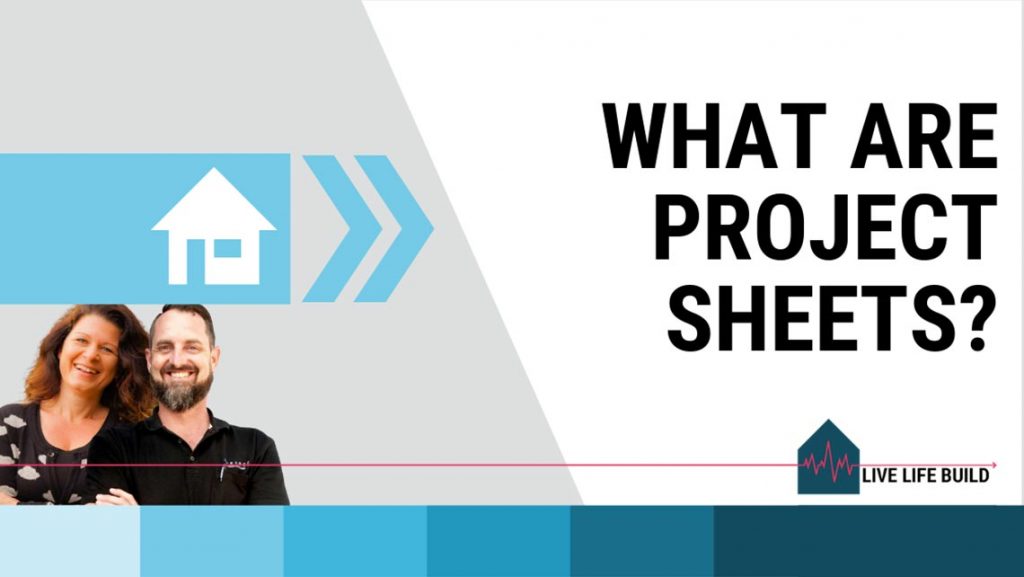Do you know if your projects are really profitable?
Learn a simple way to audit your projects, and then create a powerful tool: Your Project Sheets.
In this blog, we take you through the 5, 4, 3, 2, 1 of what you can do to simply check the profitability of your projects, better predict your future costs, and create a powerful tool to use in your business: your Project Sheets.
How often do you sit down and review your previous projects?
Too scared? Stressed that the review might tell you something you already know?
Worried it will tell you that you’re not really making as much profit as you think you are. That your projects are costing more to deliver than you’re charging your clients. And that you’re slowly, but surely, going out the back door.
It can be incredibly frustrating and scary to admit this about your business. Duayne has been there himself, and knows it can be easier to simply ignore it, or worry you don’t really know how to change the situation.
However, the simple exercise we take you through here, will change the game for you.
Not only will give you a super simple exercise to audit the performance of your previous projects: it will also help you put that information into a format that then makes it easier to predict future projects, create great relationships with designers and architects, and clearly manage client expectations around your pricing as well.
Read on to learn about a powerful tool Duayne has been using and improving in his business, and that we also teach builders inside the PAC Challenge.
It’s all about your Project Sheets.
Check out our 5, 4, 3, 2, 1 of our 6P Methodology PROJECTS: Are your projects really profitable? Learn about a powerful tool: your Project Sheets.
5. PROJECT SHEETS: WHAT ARE THEY?
You’re probably wondering what we are talking about when we mention “Project Sheets?”.
These are something that Duayne developed in his own building business as a tool to inform him what his projects were costing. Actually costing (not just what he’d charged for them).
The reason Duayne developed Project Sheets in his business was this: he was sick and tired of pricing and tendering huge amounts of work, but only winning one here and there.
He was continually getting told by architects, designers and clients, what their projects could (and should) get built for.
And of course, we work in an industry that is led by all of the large project home and volume builders. This becomes a reference point for all our pricing of custom projects. However, these guys build homes for incredibly low square meterage rates as they work on huge turnover, with very low margins.
(We won’t mention the quality).
You were most likely not taught about Project Sheets at TAFE, or at any business courses when applying for your builders licence.
They are not something that is taught by our associations when going to any seminars to educate yourself on how to run a better building business.
In fact, you will not find anything about Project Sheets anywhere else in industry, as this is something that we have created and developed ourselves.
Project Sheets are an incredible tool that Duayne has developed over several years in his business, and that we have continued to improve here at Live Life Build.
So what exactly is a Project Sheet?
Let’s start with what it’s not:
It’s not a sales document that you can give to your clients as a brochure. It’s not a document that you use as a quick reference for the types of project you can build and it’s definitely not a document that you use for any type of sales work in your business.
A Project Sheet is a document that you develop after you complete every single project that you build.
It doesn’t have to be a large document and is normally only a few pages long. A Project Sheet gives a brief description of the work involved in that particular project. It includes details about the project, such as:
- What type of site was it?
- Was there a large amount of earthworks and retaining?
- Was it the house build only or did it include additional work like fencing, pools and landscaping?
- Was it a straightforward build, a complicated build or something in between?
- A brief outline of the level of finish and fixtures
- And it can also mention any specialty products that may have been used
However, the most important part of every single Project Sheet is this.
You need to do a full cost review after every single project is completed and establish the project’s rate $ per square metre (read on to learn how to do this easily).
Once you learn how to develop Project Sheets for your building business, you will understand what an incredibly powerful tool they are, and you’ll wonder how you ever managed without them.
When you develop a library of Project Sheets, you’ll be surprised how many areas of your building business you can actually use them in.
You can use the information on your Project Sheets for things such as:
- handling a new enquiry
- educating a new client on what they may be able to achieve for their budget
- working with architects and designers to help them develop drawings that suit client budgets
- controlling costs during the design stage
- understanding what the projects you build are actually costing per square metre
- and as a quick reference tool if you are in a position to do your own developments.
Project Sheets are a simple and powerful tool for every building business.

4. PROJECT SHEETS: HOW DO YOU CREATE THEM?
Creating a Project Sheet is a really great exercise, as it’s basically a full review of every single project you’ve built at the point of project completion.
Auditing your project and putting information into your project sheet will give you a far better understanding of what was involved and what the real costs of each project actually were.
The exercise here is to determine: did you make any money? And then determine what your rate $ per square metre should be for you to actually make money on that project. This will give you greater accuracy when pricing future projects.
When establishing what rate $ per square metre to show on your Project Sheet, it’s really important to consider the following:
- Review the actual finished cost figures (ideally they’re in your accounting software) against the figures you had in your initial project proposal.
- Review what profit you made on the project by comparing the TOTAL amount that you were paid by the client, against all of the real project costs. You may not have made any profit! Look at this as a percentage.
- Now compare the percentage profit you made based on actual costs (the figure you got in #2) to the profit percentage you added to your project proposal.
(Did you make the profit you had targeted? If you’re like most builders we know, the answer will be ‘no’.)
Once you have this real life information from a completed project, you can adjust your percentages to include your desired overheads and profit. Then you can apply those percentages to the actual project cost (not what the client paid, but what it cost you to do the project).
Now, you’ll have a new total project cost that includes your desired profit and overhead margin.
Now, to make sure you get an accurate square meterage rate to put on your Project Sheet, simply divide the new figure you have worked out by the total square metres of all areas under roof and ceilings.
This gives you the right figures you need to ensure that any similar project can be priced more accurately, and will actually have your desired profit and overhead margin included.
Now that you have worked out the most important part of your Project Sheet (the square meterage rate), it’s time to add a brief description of what the project involved. We also suggest you add six to eight good quality photos that illustrate the type of project, the level of finish, and the style of the home.
Remember your Project Sheets can be used in multiple areas of your business. When you put the time and effort into your Project Sheets, they can be great documents to show potential clients, as well as architects and designers.

3. PROJECT SHEETS: THE WAKE UP CALL
One thing that we talk about a lot at Live Life Build, is how builders get caught up in a cycle taking on work to feed the machine that they’ve created.
A lot of the time that machine is a real beast! It’s not making any money, and you end up constantly chasing your tail. This can mean taking on new projects to help cover the cost of the previous ones and keep propping up your cash flow.
It can be a very confronting exercise to create your first Project Sheet, as it can highlight that your business could actually be trading insolvently and you are not making any money.
This is one of the reasons why it is so important to do this exercise of creating a Project Sheet, and understand your project cost on each project you do. This review and auditing exercise shows you if you are actually making money out of each individual project, rather than leaving it to the end of each financial year to figure out WHY you are having difficulties with your cash flow and finances.
And, because you, as a builder, are always quoting new work, it’s really important that you check each project, audit your results, and adjust your figures for the next one you are quoting.
If you’re anything like Duayne was, doing this sort of exercise can be very scary and not on your priority list.
This is how he found it:
“It’s interesting, because most people in difficult situations actually know what they need to do to improve their situation, but keep putting these actions in the ‘too hard basket’.
This was definitely the case for me. It took many years, and a lot of very stressful situations, to push him far enough to realise this: I needed to put in the time and effort required to make a difference.
Remember my favourite saying used to be just like yours: “I don’t have any time”.
So, it was not a priority, and I was scared of what I knew I would find out.
What I found was this: Most of the time I didn’t put effort into the things I needed to, because I didn’t think I had the skills to understand the outcomes. I also thought that I could handle things on my own, because I thought I didn’t have the funds to pay for outsourcing any help.
So, I’m here to tell you that I haven’t come to where I am today on my own. A huge part of running a successful business is making sure you engage with other professionals to help you.
The longer you delay, the longer it will take you to improve, and the worse position you might find yourself having to improve from.”

2. PROJECT SHEETS: COLLABORATING WITH ARCHITECTS AND DESIGNERS
So, as builders we tend to get ourselves into a lot of trouble because a lot of the time clients, and architects and designers, will call us up and ask for our advice on what we think a potential project might cost per square metre. And so we offer this information, without truly understanding if it’s accurate, or includes our desired profit and overhead margin.
We get it, as this is something Duayne used to do quite often because he hadn’t sat down and done a post-project audit exercise such as the Project Sheet.
We’ve all had that experience where a client calls with early questions about their project, and wants to pin you down on a square metre rate. They may even have a healthy square metre rate in mind, but what they picture they can achieve for that isn’t clear, and what they believe it will include may be more than that square metre rate allows for.
However, they’ll grab a figure, start working with their architect and designer, and develop a design with that early information.
And of course (this will be VERY familiar to you), they then ask you to tender on it. Of course, it’s a higher level of specification, so requires a higher rate $ per square metre, and straight away you know your price will be over their budget.
You call to advise, or submit your tender. And then have to deal with the negative feedback about why it’s not the square metre rate you mentioned in that very early phone call (way back before the design started).
You’d have the awkward conversation of justifying why it didn’t meet the same pricing level as the rate you’d mentioned early on. A change in prices, a change in finish, a higher end home, a more difficult site, etc etc.
You then have to spend a huge amount of time suggesting and making changes to the plans and specifications in an effort to get the project to a budget the client can afford.
Amelia and Duayne have been in the construction industry for a long time now and know that these steps are typically how most projects get started. The reason that they get started in this way is often because builders are not putting in the time to develop Project Sheets and understand exactly what the rate $ per square metre is on their projects.
You may wonder why designers and architects don’t keep records of what the projects they are designing end up costing to build. Duayne used to wonder this, and of course, some architects and designers do, although that information can be hard to come by when you’re outside of the process of construction as a designer.
However, as a builder, when you understand what it takes to run a professional, profitable, building business, it’s better to not be relying on figures from third parties in any case.
The only way for your building business to be successful is to understand your own project costs and use the data you are building up over each project you do. Then you can use that information to help educate your clients and other professionals that you are dealing with.
Once you build a library of Project Sheets, it’s an incredible way for you to be seen as a professional. It also helps your authority when using the PAC Process.
When you’re initiating the PAC Process with your client and an architect or designer, your Project Sheets can be used to get a starting point to set budget expectations.
Having real data is the best way to eliminate all the wasted time and money it can take designing homes that don’t meet clients’ budgets, because they started from the wrong cost rate assumptions. Your Project Sheets illustrate what project rates are based on real life examples, and make it simple to clearly communicate expectations around price points, finish levels and design styles.
One important thing to remember is that your Project Sheets are your intellectual property and are best only to shown to people. Never leave them or email them as a document.
Just imagine the relationships that you can build with designers and architects by having such powerful information about your project costs at your disposal. And how helpful you’ll be to them as well.
When they, as designers, have this information at their fingertips at the beginning of their projects, it enables them to save time, set the framework for their design approach, be confident in how they’re advising their client, and be able to design projects that are on budget without wasting loads of time and effort.

1. PROJECT SHEETS: MANAGING CLIENT EXPECTATIONS
So we’ve been talking to you about what a Project Sheet is, how to create a Project Sheet and the type of information that should be included in a Project Sheet.
Now before we go any further on this particular topic, let’s think about how much time you …
- spend responding to new enquiry emails
- talking to new enquiries on the phone
- tendering on projects that you know are nowhere near the clients’ budgets
- and how frustrated you get when dealing with designers and architects that have drawn plans nowhere near clients budgets or expectations.
Now have a good hard thing about the conversations and the emails that you’ve spent time on in these situations, and what possibly could have changed or been done to avoid you wasting so much time in these scenarios.
The game changer for Duayne in these scenarios was all about creating and having a target.
What he found was that, to have a successful project, everybody has to be on the same page. Having a target that everybody is working towards is a great way to achieve this.
Think of it like an aircraft: an aircraft takes off from one location and the pilot has to be constantly correcting the flight path depending on the weather, the other traffic in the air, delays at the next airport and so on. The target is the next airport or location that they have to land at. Building a home is the exact same scenario however, most times there is no target to aim for, as no one has collated the data to guide the journey.
Having a library of Project Sheets from all of your previous projects allows you to show your clients:
- examples of your previous projects
- the level of finish in each one
- the type of site the project was on
- and most importantly the square meterage rate each project cost to complete.
You can then guide your clients on what they can expect for their overall project budget. They will have an idea on what they can build, the size of the home, the level of finish, and what isn’t included.
This avoids an incredible amount of wasted time by all parties. It enables you to establish agreement based on a tangible reference point and real data from the outset.
It is then up to you to keep referring back to your Project Sheet throughout the design stage to make sure (like the aircraft), you keep guiding everyone involved towards the same target.

So, here’s our 5, 4, 3, 2, 1 to identify your ideal project.
5. Have you asked your team what their goals are?
4. How can you help and facilitate your team’s goals?
3. What are your goals as a team?
2. Holding people accountable.
1. Celebrate the wins and create a good work environment.
Live Life Build’s 6P Methodology unlocks the 6 ways to elevate your building business:
PERSONAL | PROJECTS | PEOPLE | PARTNERSHIPS | PROCESSES | PROFESSIONAL
Are you ready to audit your projects and create your Project Sheets?

